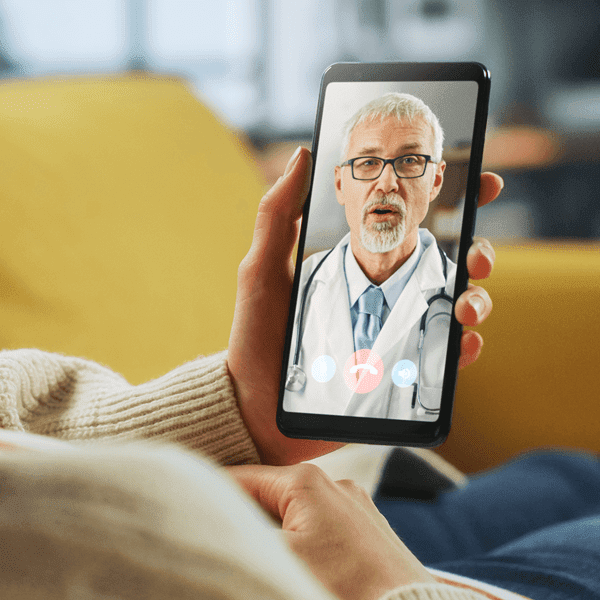About 84% of people get health information from the internet, and 37% use health-related apps, according to a 2020 peer-reviewed study. That’s why it’s vital to make your medical practice’s communications mobile-friendly. Developing a healthcare mobile marketing strategy keeps your medical practice within reach of your next patient’s search for care.
In 2021, 66% of sites were accessed on a mobile device. Bounce rates increased in the same year, suggesting that users are using their phones more than their desktops (but losing interest in the sites they find quicker than ever). Keep reading to learn how to execute healthcare mobile marketing that attracts and keeps patients on your site.
Are you ready for healthcare mobile marketing?
A robust medical marketing plan takes an omnichannel approach and uses many digital strategies. Here’s our advice: prioritize mobile marketing first.
There are two reasons to invest in healthcare mobile marketing before you do anything else:
- If your website isn’t mobile-friendly, people won’t use it (no matter how great the content and design).
- It’s more expensive to redesign your marketing strategy for smartphones than to build mobile optimization from the beginning.
No one likes pinching screens to read tiny, unresponsive web copy. Developing a mobile-adaptive website takes time and expertise, but medical practices cannot afford to ignore the growing demand for mobile-friendly marketing.
The future of mobile marketing in healthcare
Analysts predict that the mobile healthcare market will be worth $500 billion by 2025. This research refers to healthcare apps, but it has important implications for all healthcare businesses.
The growing mobile healthcare market aligns with the surging preference for smartphones over desktops. Healthcare mobile marketing allows medical practices to meet patients where they are–on their mobile devices.
Patients prefer smartphones
Over 90% of the global population uses a smartphone to go online. Research shows that large segments of healthcare consumers use their phones for medical information and services:
- 58.23% of smartphone owners use health-related apps
- 62% of smartphone owners use their devices to search for medical information on the internet
- Smartphone users are more likely to search for health-related information online than from a doctor
In 2021, 57% of total internet traffic happened on a mobile device, and that number is projected to increase. In other words, it’s time to put mobile optimization at the top of your healthcare marketing efforts.
The top 2 healthcare mobile marketing challenges
Begin your healthcare mobile marketing journey by tackling your biggest threats first: slow speed and non-adaptive websites.
Slow loading speed
The average load time for a mobile page is 15.3 seconds, but the ideal load time is zero to four seconds. Here’s what that means for your healthcare marketing strategy:
- Your competitors’ websites are probably slower than the market likes
- You need to work with a web developer who knows fantastic UX
UX web development is a gap your in-house marketing team might struggle to fill. In that case, you can work with healthcare marketers specializing in web design and web development to ensure faster load times.
Unresponsive websites
Chances are, you’ve visited a website that failed to adapt to your mobile device. The experience was likely a red flag that made you question the brand’s legitimacy.
According to Google, that’s exactly how many internet users react to unresponsive websites:
- 61% of people will move on to a competitor’s site if they don’t like yours
- 50% of people who like your brand will choose a competitor based on mobile friendliness
- 48% of smartphone owners interpret unresponsive sites as proof that a brand doesn’t care about them
- 30% of consumers feel like visiting a site that isn’t mobile-optimized is a waste of time
On the other hand, 67% of people are likely to purchase from a mobile-adaptive site, and 75% of people will return to a UX-enriched mobile healthcare site.
The data is clear: a mobile responsive healthcare website is crucial for recruiting and retaining patients.
7 questions to ask about your healthcare mobile marketing strategy
If you answer no (or aren’t sure) about any of the following questions, you may be missing out on the power of healthcare mobile marketing:
Is your healthcare website fully responsive?
A fully responsive website will adapt to multiple devices, including smartphones, tablets, and desktops. Users won’t need to manipulate the size or appearance of the site to navigate it because fully-responsive sites adapt automatically.
Is your website comparable across all devices? Is crucial information missing from your market’s mobile experience? By improving OrthoIndy’s website responsiveness, we helped the orthopedic practice increase their appointment requests by 80%. If you want to enjoy those results, check for responsiveness the next time you test your site’s performance.
Is it user-friendly?
Medical audiences are often stressed and in pain—that’s why they’re turning to your website. Is accessing your website from their smartphones a frictionless experience, or will it add to their discomfort?
We optimized OrthoNebraska’s website for mobile devices, leading to a 15% increase in mobile calls, 62% more appointment requests, and 24% more patients. Partner with a web developer who can work hard at the code, so your website feels easy for leads to use.
Does it load quickly?
The reason mobile is on the rise is convenience. Neglecting to optimize your website for mobile works directly against the market’s demand. That’s especially true when it comes to loading speed.
Effective healthcare mobile marketing understands that high-tech doesn’t necessarily mean complicated. Mobile sites that have too much going on load slowly and increase bounce rates. In fact, 40% of consumers will abandon a site if it takes more than three seconds to load.
Does the content follow natural eye movement?
People are drawn to visually appealing content. Does your website intentionally use color, size, contrast, alignment, whitespace, texture, and other graphic design elements to draw your visitors’ eyes to its most important sections?
Organize your web content to leverage natural visual patterns. That means identifying where you want people to look and incorporating graphic design techniques that guide them there. Masterful web design will enhance your website’s UX and keep patients on your page longer.
Are there clear CTAs (calls to action)?
Every page on your website has a purpose, and you win conversions by making that immediately apparent to your site’s visitors. Healthcare mobile marketing allows practices to guide their leads to action quickly.
Leading with your CTA is a healthcare web design must. Obvious, well-placed CTAs give consumers what they want: simple, clear instructions that lead them closer to wellness. Use white space, minimal copy, colors, size, and placement to entice your prospects to click.
Is it a confusing experience in any way?
Does your website have multiple CTAs on one page? Is it difficult to find or use the navigation? Are the colors inviting? Is the content readable? Your healthcare mobile marketing plan should prioritize the user’s comfort.
Ensure the simplicity of your mobile site by conducting an audit and reviewing the data. Prioritize redesigning pages with unusually high bounce and low conversion rates.
Do the colors work well?
Copy and functionality are crucial, but the first thing site visitors notice about any healthcare website design is color. Your healthcare website’s color palette may appear different depending on the device your visitors use to view it. Moreover, colors inspire different emotional responses from your prospects.
Are your buttons alarming or inviting? Do the colors on your mobile page create a busy aesthetic, or is the overall appearance clean? Instead of guessing, you can put your healthcare mobile marketing in the hands of a digital marketer specializing in graphic design.
FAQs about healthcare mobile marketing
Patients want convenient, agile solutions to their health concerns. Healthcare mobile marketing gives medical clinics the power to meet this need before the first appointment.
How do you market a mobile health clinic?
Market your mobile health clinic by following these six steps:
- Study your target medical market
- Outline the ways your healthcare services and products meet your audience’s needs
- Assess your competition’s strengths and weaknesses
- Leverage your mobile health clinic’s strengths to create marketing materials that set you apart from the competition
- Monitor your healthcare mobile marketing strategy’s performance
- Use data to refine your healthcare marketing solutions
A healthcare marketing agency will help you develop a results-driven marketing plan for your mobile health service.
How do I market my health app?
You can market your health app by using digital communications tools to promote the solutions you provide to your target audience. Effective healthcare mobile marketing tactics include the following:
- Prioritize UX during app development
- Categorize your app as a healthcare service
- Provide medical definitions to encourage health literacy
- Create a robust social media marketing campaign
- Build your healthcare mobile marketing efforts on valuable content
If you don’t have a customized app for your medical practice, consider working with a full-service marketing agency. Put your patients first by building a healthcare mobile marketing strategy (apps included) designed for their comfort.
People turn to the internet first for healthcare
The time when people called their doctors with health questions is gone. A growing number of healthcare consumers choose the internet first. The following statistics underscore the importance of healthcare mobile marketing:
- 1 billion daily Google searches are health-related
- 69% of millennials consult the internet before a doctor for medical advice
- Physicians expect to be able to use mobile devices to do their jobs
Healthcare consumers turn to the internet before they walk into your practice, and healthcare providers have adopted smartphone technology into their care. That said, your internal and external healthcare marketing can’t afford to delay mobile-first optimization.
Make your healthcare marketing website mobile-friendly
Building a healthcare mobile marketing strategy is a multifaceted, long-term project. Mobile optimization involves web and app development and an encyclopedic understanding of social media, email, and marketing analytics.
You don’t have to learn marketing, code, and web design to benefit from healthcare mobile marketing. Instead of taking on this important work alone, recruit outside help. Let our healthcare marketing agency take your website mobile, so you can bring your patients care.

